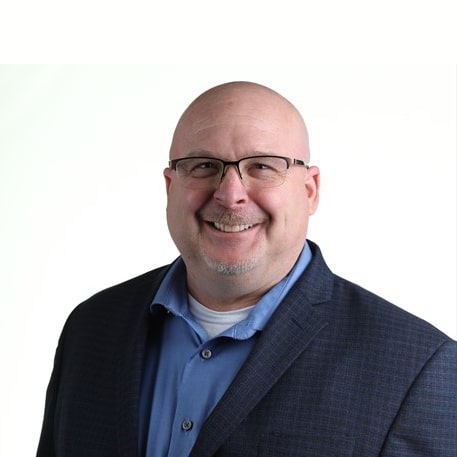
B2B Mentors: Sales Training Expert and Consultant Richard Harris on Optimizing Sales Team Training, Prospecting, and Aligning Sales and Marketing

Sales is a learned skill, practiced over time to achieve optimal results. You never stop learning, analyzing, adjusting, and growing. The buying process may change. Buyer priorities, challenges, timelines, and budgets may change. New tactics may emerge. But at the end of the day, it comes down to continued learning and team engagement. Sales Training Expert Richard Harris recently shared some valuable insights and best practices for refining sales team training and prospecting, aligning sales and marketing, and more.
How has COVID-19 altered the way B2B sales professionals approach new sales opportunities? What’s your advice for increasing their effectiveness during this difficult time (and the pending rough waves to come)?
RH: I don’t think COVID-19 has really changed the process of sales — that’s still the same. What has changed is the buying process, which is now longer now than in pre-COVID days. When approaching a prospect, it’s important to be respectful and mindful of the current situation. I recommend approaching a prospect with a simple, yet straightforward message. For example, “Hey [name], most of our customers are in one of three buckets these days. One, it’s heads down, we’re not doing anything or implementing anything new, we need to pause for the next 30-60 days. Two, still heads down, but researching things they should be looking at over the next year. And third, some customers are actually full-steam ahead and maintaining business as usual. Which bucket are you in? I’d like to talk if you’re interested; but if not, I don’t want to bother you.” This approach acknowledges the prospect’s situation and shows that you’re at least attempting to be empathetic, without being overly “in your face” about the current health and economic crisis.
COVID-19 is weeding out mediocrity in the sales process. The situation is forcing both sides of the sales conversation to ask better questions and get to the real, honest answers. We are seeing less “tire kicker” or mediocre prospects. and more sales people upping their game, understanding that the status quo or mediocre practices will no longer cut it.
Everywhere people are losing their jobs. And although it’s disappointing and sad, we also need to remember that we are not entitled to jobs, particularly in sales. So in these uncertain times, it’s important to focus on what you can control, which includes seeking out opportunities to improve professionally and personally.
“Success will not lower its standards to accommodate you; rather, you raise your standards to achieve it”
— Mr. Vybs Live
We are in this unfortunate downturn — and even if you’re great at sales, but the company just couldn’t make it — you still need to keep investing in yourself. That’s the most important thing you need to do because that’s what you can control.
There’s a ridiculous amount of free content out there right now. You can invest in yourself in a number of different ways, such as:
- Attend virtual happy hours or coffee hours.
- Follow key influencers and thought leaders on social channels.
- Take a class.
- Read a book.
- Practice meditation
What are many sales teams getting wrong when it comes to sales training and what can they do to course correct to build a stronger team?
RH: The problem is, many sales teams are expected to learn from single exposure to reading a book, watching a video, or participating in a training. I don’t know anyone who learns how to get good at doing anything doing that, with no consistency or reinforcement of the information. Yet it’s expected that the single training opportunity should stick immediately.
So what people are getting wrong? There’s no coaching and a lack of accountability across the team. Teams are not clearly defining the expectations and methods for measurement. And it’s been that way for years.
When it comes to sales standups, any standup is better than nothing. But I think there are better standups than a mini pipeline review and ‘what are we trying to close today’ conversations. If I’m going to spend 10 minutes a day with my team during a standup — which might be the only interaction I get with them (particularly now that most of us are remote) — I’d encourage my team to practice a specific sales tactic every week, with daily practice and coaching. This method helps to ensure consistency and will ensure the skill sticks.
Ideally, teams should pick one tactic to focus on per week. However, if you find that you have some sales reps who are already solid on a particular tactic, you may choose to use two tactics within a week to focus on, giving an option to those reps to focus on an area that could use improvement. That, to me, is a daily standup. I would coach on the tactic first and then talk about the pipeline and how you can implement that tactic within your pipeline second.
What is your advice for bridging the gap between sales and marketing teams to improve communication, processes, and overall effectiveness?
RH: People are either going to love me or hate me for this, but I believe marketing needs to carry a revenue number. Not just marketing qualified leads (MQLs) or sales qualified leads (SQLs), but an actual revenue number. When I say revenue goal, I’m referring to closed revenue which freaks out many marketing professionals and excites many sales professionals. Until marketing is forced to carry a piece of the revenue goal, there’s always going to be a gap between the teams.
What we are really talking about, by the way, is a compensation discussion. The division is based on the fact that each team is compensated differently. It doesn’t mean that those other key performance indicators (KPIs) don’t matter (they do) and that they can’t be a part of the compensation plan (they should), but MQLs should not be the primary driver of someone’s compensation.
It creates richer conversations and a massive feedback loop between sales and marketing when everyone is focused and compensated on a common goal.
What are some of the most effective types of marketing/sales content that you’ve used in the sales process?
RH: For me, it’s always been about the use case and the case study. People buy stories. They buy pictures in their minds. If you think about it, there’s a picture in your mind whenever you talk. However, that short distance between your brain and your mouth creates a barrier to that picture and it is never discussed; rather, words are discussed.
So anything that can help draw the picture is, for me, the most important thing. Sometimes that picture can be a specific use case, a top 10 list, how-to article on doing something differently — it just depends on the conversation. But I think people need more of a story than they need other things. And you can use good data to tell that story.
What do you wish you had known when you started out in sales? What would you tell a younger you?
“Stop being such an asshole.”
Every generation feels entitled. It’s not a millennial thing. Every generation has had a sense of entitlement. I wish I had been less entitled and stopped acting that way. I wish I would have been open to seeking out coaching. Unfortunately, I avoided those scenarios because I believed that I could stand on my own, and didn’t need help from anyone else. After all, why would I need help, I was obviously an expert. And I think that was a really bad place for me to be. It still comes up from time to time, and I’ll say to myself that I don’t need the help. But at least now I know to check myself when that happens and seek coaching or help, when needed.

About the Author:
Richard Harris brings 20+ years of sales and SaaS experience to the table in his work as an advisor and consultant. His focus is on a more relaxed conversational selling style that helps people go from strangers to acquaintances to trusted business allies. The goal of Richard’s training is to get people to stop talking about what they do and get them to start talking about the pains they solve. Clients and experiences include Visa, Google, Zoom, PagerDuty, Headspace and Gainsight.
Richard has been named a Top 25 Inside Sales Professional by the American Association of Inside Sales for the last 4 years. As well as a Top 10 Sales Development Leader as voted by Inside Sales and Sales Hacker. Published in Huffington Post, Inc, and most recently NBC News. Richard lives in Northern California with a wife, Cathy, 2 boys, Riley (9) and Bodhi (7), and their dog Lola.



